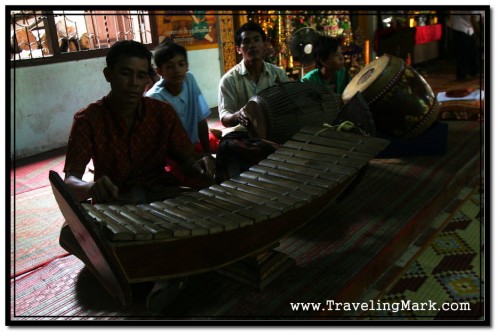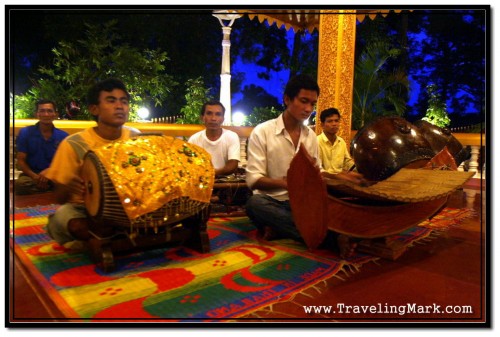Pinpeat Orchestra is basically a Cambodian musical band playing traditional Khmer music on traditional Khmer instruments. Pinpeat Orchestra music sounds very oriental but for the most part it doesn’t appear to have any beginning or end, rather the musicians just improvise by randomly striking notes on their instruments that then blend into a musical piece that sounds just as any other musical piece by Pinpeat Orchestra. Still, even though lacking in variety, Pinpeat Orchestra is the classical music of Cambodia and does have the oriental feel you would expect from such ensemble.

Pinpeat Orchestra Instruments
Vast majority of Pinpeat Orchestras I’ve seen playing in Cambodia had their music based on percussions. Most Pinpeats were solely percussions based, while few smaller ensembles that make their living by selling CDs at Angkor Wat temples also used fiddle like string instrument called “tro”.
Roneat (Khmer Xylophone)
Roneat is the most typical instrument found in a Pinpeat Orchestra. Some traditional Cambodian bands use Roneat as their sole instrument. Roneat looks like Xylophone but uses wood bars suspended on a string. Person playing Roneat usually holds two mallets one in each hand and strikes two wood bars at the same time in what seems as completely random order.

Sampho Drum
Sampho is a barrel shaped drum with heads on both sides. Person playing Sampho uses both hands to strike the drum each on either sides of the barrel. Sampho player usually sets and keeps the tempo of the song being played.

Skor Thom
Skor Thom is a set of two barrel shaped drums played with sticks. Not all bands use it. Sometimes Sampho is enough to keep the beat going.
Kong Thom
Kong Vong Thom is a gong circle which along with Roneat makes for an important part of a Pinpeat Orchestra. Gongs of different sizes are hung on the strings of a circular frame. Just as it goes with Roneat, player playing Kong Thom holds two mallets in his both hands and strikes two gongs at the same time in what appears as random order.
Ching Cymbals
Ching cymbals are the most irritating part of every Pinpeat Orchestra. It’s a pair of small cymbals held between the fingers of hands which when struck together sound like those ringers on old bicycles. You can typically hear it long before you can hear the rest of the band. If you are walking towards the temple and can hear a sound which sounds as if someone was running their bicycle ringer amok, you may actually hear the whole Pinpeat Orchestra once you get closer.

In Siem Reap, there is a Pinpeat Orchestra with members who are victims of landmine accidents. They play each night on Pub Street in Siem Reap. You could be sitting in the Temple Bar with loud music and this ringing of Ching cymbals will be in your ears, giving you the headache non stop. If you go to a quiet restaurant a block away, you will be too far to hear the band, but ringing of Ching cymbals will be there tearing your eardrums like there’s no tomorrow. It’s an extremely loud and invasive sound and it comes from two tiny cymbals each size of half of your palm. Luckily, not all Pinpeat Orchestras use Ching cymbals so you don’t have to go shoot yourself in the head each time you want to watch Apsara dance.
Yes, Apsara dancers always dance to traditional Khmer music which is played by a Pinpeat Orchestra. My first exposure to live Pinpeat Orchestra was at Preah Ang Chek Preah Ang Chorm Shrine and when I saw amateur Apsara dancers at Wat Keseram they were also dancing to the music played by live Pinpeat Orchestra. Even though I was told on several occasions that typical Pinpeat Orchestra also uses wind instruments, I have never seen one that does. Fiddle like Tro was the only instrument used on top of the above mentioned ones. Both bands mentioned in this paragraph only used the instruments listed – no wind, no Tro. That’s my personal experience.